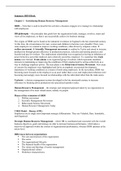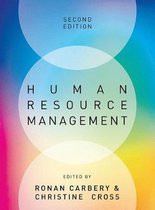Summary HRM Book
Chapter 1 – Introducing Human Resource Management
HRM – Term that is used to describe the activities a business engages in to manage its relationship
with employees.
HR-philosophy – the principles that guide how the organization leads, manages, involves, treats and
views all its employees, so that it can successfully achieve its business strategy.
The origins of HRM can be found in the industrial revolution in England in the late nineteenth century.
At this time, the circumstances for men, women and children in factories were dreadful. There were
some employers wo wanted to improve working conditions, often driven by religious values
welfare movement Scientific Management movement is credited to Taylor and aimed to increase
productivity through greater efficiency in production practices, selection and training practices and
incentivized pay for workers. The employment relationship was recognized as having an imbalance of
power between a powerful employer and a relatively powerless employee. To counteract this trade
unions were formed. Trade unions is an organized group of workers which represents members’
interests in maintaining or improving the conditions of their employment by acting collectively as a
way to challenge employer power. The next phase is the Behavioural Science Movement. New areas
of concern for employers were highlighted and led to an emphasis on personal development,
importance of working conditions as a means of motivating employees. In the next phase, HRM was
becoming more focused on the employee as an asset rather than a cost, and employment relations were
becoming increasingly more focused on relationships with the individual rather than the trade union.
Taylorist – a factory management system developed in the late nineteenth century to increase
efficiency by breaking down production into specialized repetitive tasks.
Human Resource Management – the strategic and integrated approach taken by an organization to
the management of its most valued assets, namely its people.
Phases of the evaluation of HRM
1. Welfare movement
2. Scientific Management Movement
3. Behavioural Science Movement
4. Human Resource Management Today
VIRO Model – Barney (1991)
Employees are its single most important strategic differentiator. They are Valuable, Rare. Inimitable,
and Organized.
Strategic Human Resource Management – where HR is coordinated and consistent with the overall
business objectives, goals and strategy in order to increase business performance, which takes a
macro-level approach within the context of organizational performance, whereas HRM operates at the
micro-level.
Differences between organizations
The size and structure of the organization
The sector
The organizational lifecycle
The financial health of the organization
The values and ideology of senior management
Organizational culture
Workforce characteristics
, Established custom and practice (the structure of process of working established in the
organization)
Factors of the external context
Competition
Technology
Labour market
Legislation and regulation
Ethics
Four critical features of HRM (John Storey, 1989)
1. HRM is explicitly linked with corporate strategy
2. HRM focuses on commitment rather than compliance of employees
3. Employee commitment is obtained through an integrated approach to HR policies in the areas
of rewards, selection, training and appraisal
4. HRM is not just the domain of specialists in the HR function; rather HRM is owned by line
managers as a means of fostering integration
Vertical integration – the matching of HRM policies and practices with business strategy (external
alignment/external fit)
Horizontal integration – involves strong consistency and interconnection between HRM policies and
practices internally, in order to achieve effective performance (internal alignment/internal fit).
Employee lifecycle – how employees are attracted to the organization, how they are recruited and
selected, how their performance is managed, how they are developed, rewarded, engaged over time,
and how they come to exit the organization. (Attract & select, manage & develop, reward & retain,
separate).
A HRM approach aims to enable everyone in the organization to contribute fully to meeting the
organizations strategic objectives. When HRM practices are integrated and mutually reinforcing, so
that they produce an effective outcome at an organizational level, then we speak of a high-
performance work system.
HR does not exist to serve the employee, but exists to enable a successful and sustainable business for
its owners.
Ways that the HR strategy can be linked to business strategy
1. A separation model where there is no connection between the two
2. A fit model where the organizational strategy precedes and influences the HR strategy
3. A dialogue model where the HR strategy has an opportunity to influence the business strategy
as it is being developed
4. A holistic model where they are developed tandem
5. A HR-driven model
The more engaged the CEO is with the concept of their organization’s human resources as a strategic
asset, the more likely they are to engage in an HR structure with increased levels of influence over the
business strategy.
Organizing HR practices
Specialist – follows the livecycle of the employee
Generalist – works with a specific group of employees and handles all the issues related to that
group
Fact: Only 15% of HR time is spend on strategic activities
,Shared services approach – where all the routine ‘transactional’ HRM services are provided from a
central location to all parts of the business. Benefit: this reduces the number of HR employees working
at an operational level and it allows them to focus on taking a more strategic approach.
HR practitioners have an impact across four different dimensions
1. They operate at an individual level – building effective relationships and good reputations
across the business.
2. They operate organizationally – as they are responsible for the design and delivery of
appropriate HR practices that reach right across the organization.
3. They operate contextually – as their understanding of the internal and external environments
specific to their organization are vital in developing the appropriate HR strategy.
4. They operate at a strategic level – as they have a role in developing leader, manager and
employee perceptions of the HR function adding value and enabling them to deliver on the
business strategy, rather than just managing the more basic operations of the employment
relationship.
Competencies of HRM function
Credible activists – deliver promises, are trusted and take action in a positive manner.
Capability builders – identify the core processes which will positively impact on the business
strategy.
Change champions – enable the organization to respond to the external pressures and pace of
change, engaging their stakeholders, and being adaptable and flexible.
Innovators and integrators – use of the latest scientific evidence to continuously develop HR
practices.
Technology proponents – use HR analytics to ensure HR practices are positively impacting
the business strategy, also having the skills to leverage available technologies.
Michigan Model – Fit/contingency model
Stresses the importance of the fit between the HR strategy and the business strategy (vertical
integration/external alignment) and between the HR practices themselves (horizontal
integration/internal alignment). The choice of HR strategy is contingent on the context of the
organization and its business strategy. External alignment is key issue. Appears to be most effective in
service environments.
Criticisms of the model
A one-way nature of the HR and business strategy relationship
The lack of recognition of employee interests and behaviour choice, in that is assumes that all
employees are the same.
Universal/soft approach (HR territory map)
Recognizes the influence that various stakeholders and situational factors have on the development of
HR policies and practices. Each stakeholder has different interests and the model assumes that these
interests are legitimate. Therefore, they should be reflected in the HRM strategy, which is as closely
aligned to the business strategy as possible. Situational factors must also be considered in the
development of the HR strategy (economic climate, state of the labourmarket, characteristics of the
workforce, trade union membership and legislation. Main focus: how the development of the HR
practices, incorporating these stakeholder interests and situational factors, will lead to a change in
organizational behaviours or the building of organizational capabilities, which in turn lead to specific
organizational outcomes.
Criticisms of the model
Manager and employee interests are only being considered to meet the needs of the employer
, Complexity and high-involvement approach; it suggests there is a formula for building
organizational capability, but does not provide a list of HR practices for organizations to
follow.
Guest model
Considered the benefits of both the low-involvement and high-involvement models. In an effort to
balance the fit and universal element, he built on these models by identifying four key principles that
would combine to increase organizational effectiveness:
Strategic integration
High commitment
Flexibility
High quality
Universalist approach
Focuses on the existence of one set of HRM best practices aimed at creating and enhancing high levels
of employee commitment and performance; these will result in superior levels of organizational
performance, regardless of the context in which the organization operated and the competitive strategy
of the firm.
Pfeffers (1998) set of HRM practices
1. Recruiting the right people
2. High wages clearly linked to organizational performance
3. Employment security
4. Information sharing
5. Investment in training and skill development
6. Self-managed teams and decentralized decision-making
7. Reduced status differentials
Chapter 2 – Workforce planning and talent management
Workforce planning – the process through which an organization ensures it has the right number of
people with the right skills in the right place and at the right time, to help deliver an organizations
short and long term objectives (predicting the unknown). It’s an open-ended process, as long as the
organization is still in operation, the HR function will be making workforce plans. It occurs in a
continuous cycle:
1. Stocktaking – the stage where organizations must identify a range of factors currently
impacting its operations (both internal and external factors).
2. Forecasting – the stage where the organization must predict the demand for and supply of
labour in order to meet the strategic goals of the firm (most difficult task). The organization
examines both internal and external sources.
a. Internal: the extent to which current staff can help to achieve the strategic objectives
of the firm (including skills, motivation, knowledge etc.) Succession planning page 24
b. External: looking outside of the organization and assess the extent to which the
external labour market can provide suitably qualified personnel (more difficult)
3. Develop action plans – the stage where the organization makes a specific plan regarding how
best to use the workforce to help meet the strategic goals of the firm.
4. Implementation
5. Assess and adjust plans if required – plans need to be constantly monitored and adjusted if
required.
Flight-risks – employees that may seek more secure employment elsewhere.
Future lens – preparing today’s employees to address tomorrow’s challenges.
Talent management – the systematic and integrated approach taken within an organization to the
attraction, recruitment, engagement and retention of those employees who have been identified to be
of particular value to the strategic development of the firm. But, it does not occur in a vacuum and






